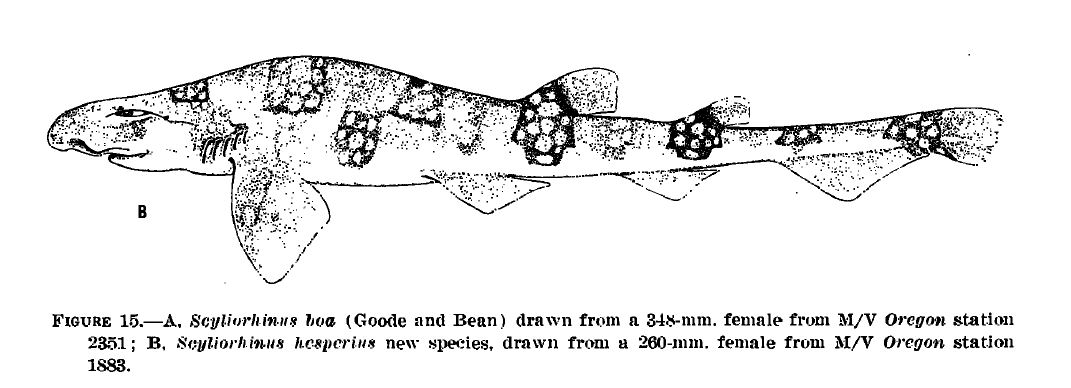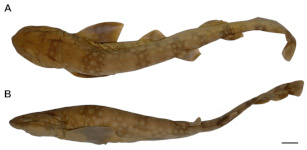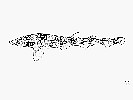Scyliorhinus hesperius
Springer, 1966
Whitesaddled catshark
Classification: Elasmobranchii Carcharhiniformes Scyliorhinidae
Reference of the original description
A review of Western Atlantic Cat Sharks, Scyliorhinidae, with descriptions of a new genus and five new species. Fishery Bulletin, 65(3), 581–624
A review of Western Atlantic Cat Sharks, Scyliorhinidae, with descriptions of a new genus and five new species. Fishery Bulletin, 65(3), 581–624
Image of the original description

Scyliorhinus hesperius Springer, 1966, drawn from a 260 mm TL, female, from M/V Oregon station 1888.

Scyliorhinus hesperius Springer, 1966, drawn from a 260 mm TL, female, from M/V Oregon station 1888.
Description :
Citation: Scyliorhinus hesperius Springer, 1966: In: Database of modern sharks, rays and chimaeras, www.shark-references.com, World Wide Web electronic publication, Version 04/2024
Please send your images of "Scyliorhinus hesperius" to info@shark-references.com

Scyliorhinus hesperius Springer, 1966, Guatemala’s Caribbean Sea © Dra. Ana Hacohen Domené

Scyliorhinus hesperius Springer, 1966, Guatemala’s Caribbean Sea © Dra. Ana Hacohen Domené
Common names
 Alitán ensillado,
Alitán ensillado,  Roussette selle blanche,
Roussette selle blanche,  White-saddled cat shark,
White-saddled cat shark,  Whitesaddled catshark
Whitesaddled catshark
 Alitán ensillado,
Alitán ensillado,  Roussette selle blanche,
Roussette selle blanche,  White-saddled cat shark,
White-saddled cat shark,  Whitesaddled catshark
Whitesaddled catshark
Short Description
Diagnosis after Compagno, 1984 [517]: Field Marks: A fairly small, slender, dark-saddled catshark with large, white spots covering saddles but usually with light spaces between saddles, no black spots, small anterior nasal flaps that end in front of mouth, no nasoral grooves, labial furrows on lower jaw only, second dorsal fin much. smaller than first. Diagnostic Features: Head and body relatively deep, slender and narrow; greatest width of head about 2/3 of head length; no nasoral grooves; anterior nasal flaps not expanded and falling just short of mouth. First dorsal origin somewhat behind pelvic insertion; second dorsal origin somewhat anterior to anal insertion; interdorsal space slightly greater or slightly less than anal base. Denticles small and flat, surface of skin relatively smooth. Colour pattern of 7 or 8 dusky saddles densely covered with large light spots at least as large as eye pupil, these sometimes extending to spaces between saddles; no black spots. Size moderate, adults below 50 cm.
Diagnosis after Compagno, 1984 [517]: Field Marks: A fairly small, slender, dark-saddled catshark with large, white spots covering saddles but usually with light spaces between saddles, no black spots, small anterior nasal flaps that end in front of mouth, no nasoral grooves, labial furrows on lower jaw only, second dorsal fin much. smaller than first. Diagnostic Features: Head and body relatively deep, slender and narrow; greatest width of head about 2/3 of head length; no nasoral grooves; anterior nasal flaps not expanded and falling just short of mouth. First dorsal origin somewhat behind pelvic insertion; second dorsal origin somewhat anterior to anal insertion; interdorsal space slightly greater or slightly less than anal base. Denticles small and flat, surface of skin relatively smooth. Colour pattern of 7 or 8 dusky saddles densely covered with large light spots at least as large as eye pupil, these sometimes extending to spaces between saddles; no black spots. Size moderate, adults below 50 cm.
Distribution
Western Central Atlantic: Honduras, Panama, and Colombia.
first record: 2016: Guatemala’s Caribbean Sea (n=5 males) [24758]
Western Central Atlantic: Honduras, Panama, and Colombia.
first record: 2016: Guatemala’s Caribbean Sea (n=5 males) [24758]
Human uses
fisheries: of no interest
fisheries: of no interest
Size / Weight / Age
470 mm TL (female)
470 mm TL (female)
Habitat
bathydemersal; marine; depth range 274 - 457 m
bathydemersal; marine; depth range 274 - 457 m
Dentition
Monognathic heterodonty gradual well developed; anterior teeth abruptly larger than the parasymphysial ones and lateral teeth smaller distally, with smaller and thicker principal cusps (Fig. 52). Sexual heterodonty not observed; only adult females examined. Tooth counts 20–26 19–25/20–25 1 19–25 (24–25/24–22). Parasymphysial teeth with a principal cusp flanked by one cusplet on each side; cusplets 1/3 the height of the principal cusp. Protuberances on medial portion of the crown base and striae from the crown base toward the apex of the principal cusp. Anterior teeth larger than the parasymphysial and principal cusp less stout. Anterior teeth with three to four cusplets; marginal cusplets, when present, poorly developed. Anterior upper teeth with proximal cusplets corresponding to half the height of the principal cusp; cusplets 1/3 the height of the principal cusp in lower teeth. Protuberances on the crown base and striae extending throughout the principal cusp. Lateral teeth with three cusplets; two cusplets at the mesial edge and one at the distal edge. Mesial proximal and distal cusplets corresponding to half the height of the principal cusp and mesial marginal poorly developed. Principal cusp semioblique in both jaws. Protuberances on the crown base and striae extending throughout the crown. Commissural teeth with three cusplets; principal cusp stronger, semioblique and laterally situated. Mesial proximal cusplet slightly smaller and 2/3 the width of the principal cusp. Protuberances well prominent on the crown base and striae extending throughout the crown. Ectodermal pits present in lateral and commissural teeth, restricted to the crown base. [27296]
Monognathic heterodonty gradual well developed; anterior teeth abruptly larger than the parasymphysial ones and lateral teeth smaller distally, with smaller and thicker principal cusps (Fig. 52). Sexual heterodonty not observed; only adult females examined. Tooth counts 20–26 19–25/20–25 1 19–25 (24–25/24–22). Parasymphysial teeth with a principal cusp flanked by one cusplet on each side; cusplets 1/3 the height of the principal cusp. Protuberances on medial portion of the crown base and striae from the crown base toward the apex of the principal cusp. Anterior teeth larger than the parasymphysial and principal cusp less stout. Anterior teeth with three to four cusplets; marginal cusplets, when present, poorly developed. Anterior upper teeth with proximal cusplets corresponding to half the height of the principal cusp; cusplets 1/3 the height of the principal cusp in lower teeth. Protuberances on the crown base and striae extending throughout the principal cusp. Lateral teeth with three cusplets; two cusplets at the mesial edge and one at the distal edge. Mesial proximal and distal cusplets corresponding to half the height of the principal cusp and mesial marginal poorly developed. Principal cusp semioblique in both jaws. Protuberances on the crown base and striae extending throughout the crown. Commissural teeth with three cusplets; principal cusp stronger, semioblique and laterally situated. Mesial proximal cusplet slightly smaller and 2/3 the width of the principal cusp. Protuberances well prominent on the crown base and striae extending throughout the crown. Ectodermal pits present in lateral and commissural teeth, restricted to the crown base. [27296]
Remarks
shark-references Species-ID=6324;
shark-references Species-ID=6324;



















